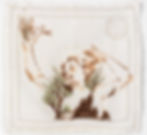When Mythological Women Get Their Due
- artandcakela
- Aug 12
- 4 min read
I'm sitting here looking at photos from Heather Beardsley and Alexandra Carter's upcoming exhibition Stitched and Stained, and I keep coming back to the same thought: this is what real collaboration looks like.
I've been thinking about collaboration a lot lately (okay, constantly—it's basically my entire thing). There's something magical that happens when artists truly connect and create together. It's different from splitting a gallery rental or hanging work in the same space—it's about finding that creative language you can only speak together.
What Heather and Alexandra are doing is something else entirely. They're creating a third voice that neither could make alone.
The process starts with Alexandra painting mythological women in cranberry juice on antique linens. Yes, cranberry juice—from her family's farm in Massachusetts, because of course it is. The personal is always political, and the political is always personal, especially when you're dealing with stories about women being transformed against their will.
Then she mails the drawings to Heather in Virginia Beach, who responds with embroidery. Not just decorative stitching, but actual conversation. Heather told me she sometimes sits with Alexandra's drawings for days before she knows how to respond. That waiting, that living with someone else's vision before adding your own—that kind of collaboration is beautiful.

The Subject Matter Hits Different Right Now
They're focusing on women from mythology whose stories involve transformation: Daphne fleeing Apollo's pursuit and choosing to become a tree. Arachne transformed into a spider for the power of truth-telling. Lilith, choosing exile from Eden over submission.
The mythological retellings trend is everywhere right now—everyone's reading Madeline Miller and Circe is on every book club list. But what Heather and Alexandra are doing goes deeper. They're exploring why these particular women speak to us right now, in 2025, when questions of autonomy and agency feel so urgent.
The timing of this exhibition isn't accidental. When Heather talks about how these ancient stories of punishment for transgression echo "ongoing struggles over bodily autonomy and the policing of female agency," she's not being subtle. She's being necessary.

The Materials Tell Their Own Story
Every material choice is intentional. The cranberry juice that stains and oxidizes over time, shifting from red to brown like old blood. The antique linens sourced from eBay and thrift stores, carrying the anonymous labor of women who embroidered them decades ago. The fact that these textiles were meant for domestic use—tablecloths, napkins, the stuff of women's daily work—and now they're carrying images of women who refused to be domesticated.
Alexandra calls the original embroiderers "anonymous collaborators," and Heather connects this to the oral tradition that shaped mythology itself. "Like oral storytelling, our conversation spans time and space," she said. That gave me chills. They're not just making art about mythological women—they're participating in the same kind of collective storytelling that created these myths in the first place.

What Collaboration Actually Looks Like
I've been facilitating collaborations through my Call and Response program since the pandemic started, so I know how rare it is to see two artists actually change each other's work. Usually, everyone wants to maintain their individual vision. But Alexandra told me that working with Heather has changed how she approaches the initial drawings. She's learned to leave more ambiguity, more space for transformation.
That's trust. That's also incredibly hard.
And Heather's response when she receives Alexandra's packages—sometimes as many as twelve pieces at once—is to live with them before deciding how to intervene. She's not rushing to make her mark. She's listening first.
The physical rhythm of mailing work back and forth slows everything down in a culture that demands instant everything. There's something radical about that enforced pause, that built-in time for reflection.
Why This Matters Beyond the Gallery
When I think about the artists I work with through Shoebox Arts and the community we've built at the Brewery, I see how much we all crave genuine creative partnership. Not networking. Not career advancement. Actual artistic dialogue.
What Heather and Alexandra have figured out is how to maintain their individual practices while creating something entirely new together. Alexandra still makes her fertility goddess paintings in her solo work. Heather still focuses on environmental issues in her other projects. But in Stitched and Stained, they've found a shared language that neither could speak alone.
That's what collaboration should be: not a dilution of individual vision, but an amplification of it.
The exhibition opens this week, and I'm excited to see how viewers respond to the intimate scale of these works. At 10 to 15 inches each, they invite close looking. You have to lean in to see Heather's delicate stitching, to trace where Alexandra's cranberry juice marks begin and Heather's embroidered responses continue.
In a moment when so much art is designed for Instagram, there's something wonderful about work that insists on physical presence, on slowing down, on the kind of attention that only happens when you're standing in front of the actual object.

The Bigger Picture
I keep thinking about what these mythological women represent—not just as artistic subjects, but as models for creative practice. They're all figures who found ways to transform and survive, who continued to exist and create even after being changed.
That feels like a beautiful metaphor for making art as a woman in 2025. Or for making collaborative art that expands beyond the individual artist narrative. Or for using materials and techniques that have been historically overlooked to address contemporary questions.
Heather and Alexandra aren't just making beautiful objects (though they are beautiful). They're demonstrating what it looks like to turn constraint into creativity, separation into connection, ancient stories into urgent contemporary dialogue.
Stitched and Stained: A Collaboration by Heather Beardsley and Alexandra Carter opens August 16th, 6-8pm at The Middle Room in Los Angeles.




